I’ve reviewed a whole load of the new crop of shoe mount light meters recently. I’ve liked something about all (most) of the meters I’ve tried, but trying them in quick succession has also revealed the shortcomings of each of them to me too. As such, I thought it might be useful to make a bit of a comparison article looking at their various pros & cons.
Just my opinion/experience
Before I get into this, I just want to labour the point this all of this is still just my opinion and my personal experience with some (not all) of the shoe mount light meters on the market today. Your mileage may well vary. That said, hopefully this should still provide useful reading for anyone who’s got themselves into a bit of choice paralysis. I know I’d probably be a little confused we’re I trying to pick one and hadn’t had the opportunity I’ve had to play with all of them.
Voigtlander VCii
I shall start with the one I have had for the longest, the Voigtlander VCii. Of all the shoe mount light meters here, this one remains a firm favourite of mine. A little bit of this might be the fact that I’ve had it for ages, and am very used to how it works, but I also think that it’s a great design, mostly at least.
That said, I have been known to curse it for the fact that the battery chamber on mine pops open spilling the batteries on a whim. I’ve also read others talking about this issue in other reviews and forum threads. It’s only really a minor annoyance, as a bit of bluetac in the door fixes it, but for what they go for second hand, I’d expect more.
On the plus side, it’s easy to read with it showing the correct settings and reciprocal settings thanks to the lines that join the readings together on the top. It’s just a shame the LEDs are just arrows, meaning which LED denotes over and which denotes underexposed isn’t immediately obvious. Regular users won’t find this an issue, but sporadic users (like me) might find it a bit of a faff having to get their head around what the readings mean each time they use it.
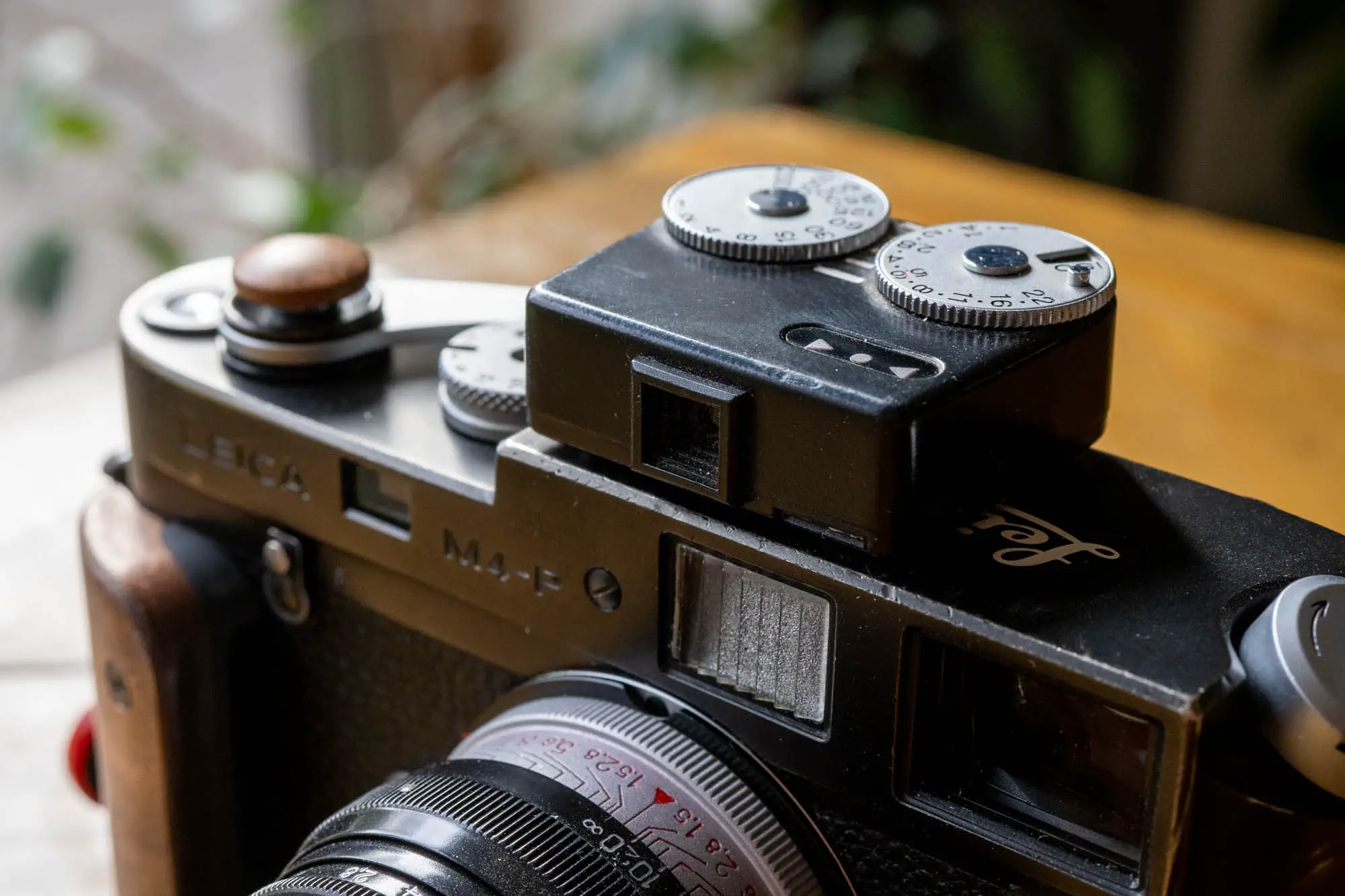
Pros
- Reciprocal readings easy to see
- “Analogue” dials will appeal to some
- Solid build quality
- Accurate metering
Cons
- Settings range limited by dials compared to the OLED meters
- Battery compartment can spill batteries
- LEDs just arrows (rather than more obvious +/-)
- Expensive (more than twice the price of the others here)
For more details, you can find my complete review of the Voigtlander VCii meter here
Reveni Labs Light Meter
The Reveni was the first of the new crop of shoe mount light meters I tried. It’s advantages and disadvantages were immediately apparent to me too. This meter is the smallest light meter on the market (as far as I know of at least). It’s footprint is only slightly bigger than a cold shoe meaning it can be quite readily mounted to essentially any camera that has one. A wide range of mounting accessories are also available.
With the small size comes a the disadvantage of slightly hindered user experience. It’s not quick to use, and the buttons are tiny making it feel quite fiddly.
It does have the option to be calibrated by the user, and can be set to display the reading in EV before showing shutter and aperture settings.
It also has a wide range of settings – the shutter speed range goes from 1 hour to 1/8000th and the aperture settings range from f/0.7 all the way to f/1024 making it usable with pinhole cameras.
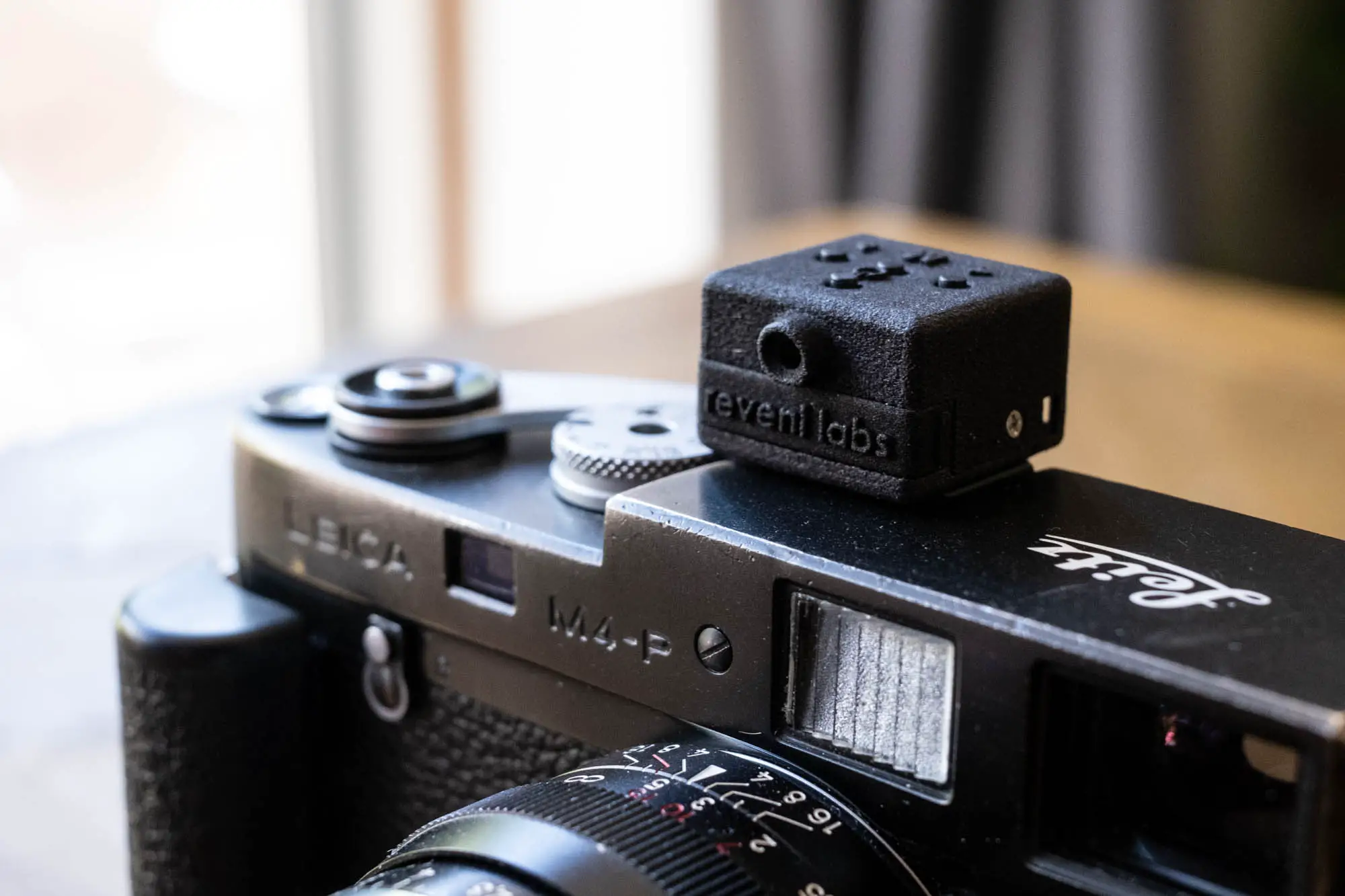
Pros
- Tiny. I can’t think of a camera I couldn’t mount it too
- Allows for user calibration
- Can be set to display EV reading
- Wide range of settings
- Wide range of mounting accessories
Cons
- Fiddly to use
- Slow to use
- Goes a bit weird/slow when batteries are dying
For more details, you can find my complete review of the Reveni here
Hedeco Lime One
The Hedeco Lime One has now been discontinued and replaced by the Lime Two (below)
The Hedeco is the most expensive of the shoe mount light meters here. For that though, it does answer a lot of the questions you could ask of a light meter of this size with little in the way of compromise.
To begin with, the one I received out of the box was bang on accurate to my eye. It can also be user calibrated. It also displays EV along side the shutter and aperture settings and has a exposure compensation mode.
The settings range isn’t quite as wide as the Reveni, but thanks to the dial used to change the settings, it is dramatically faster to use. In fact, it is the fastest of all the OLED meters compared here.
The only thing I feel is left wanting is a bit more substance to its build. It’s so small and light that it just feels a little insubstantial somehow, but that is nitpicking really I think. Some might also struggle with the tiny size of letters/numbers on the display.
It is also worth noting that as of writing this article it is not yet available to purchase. It was funded on Kickstarter, and appears to be on the way, so if you like the look of it, you might just have to wait.
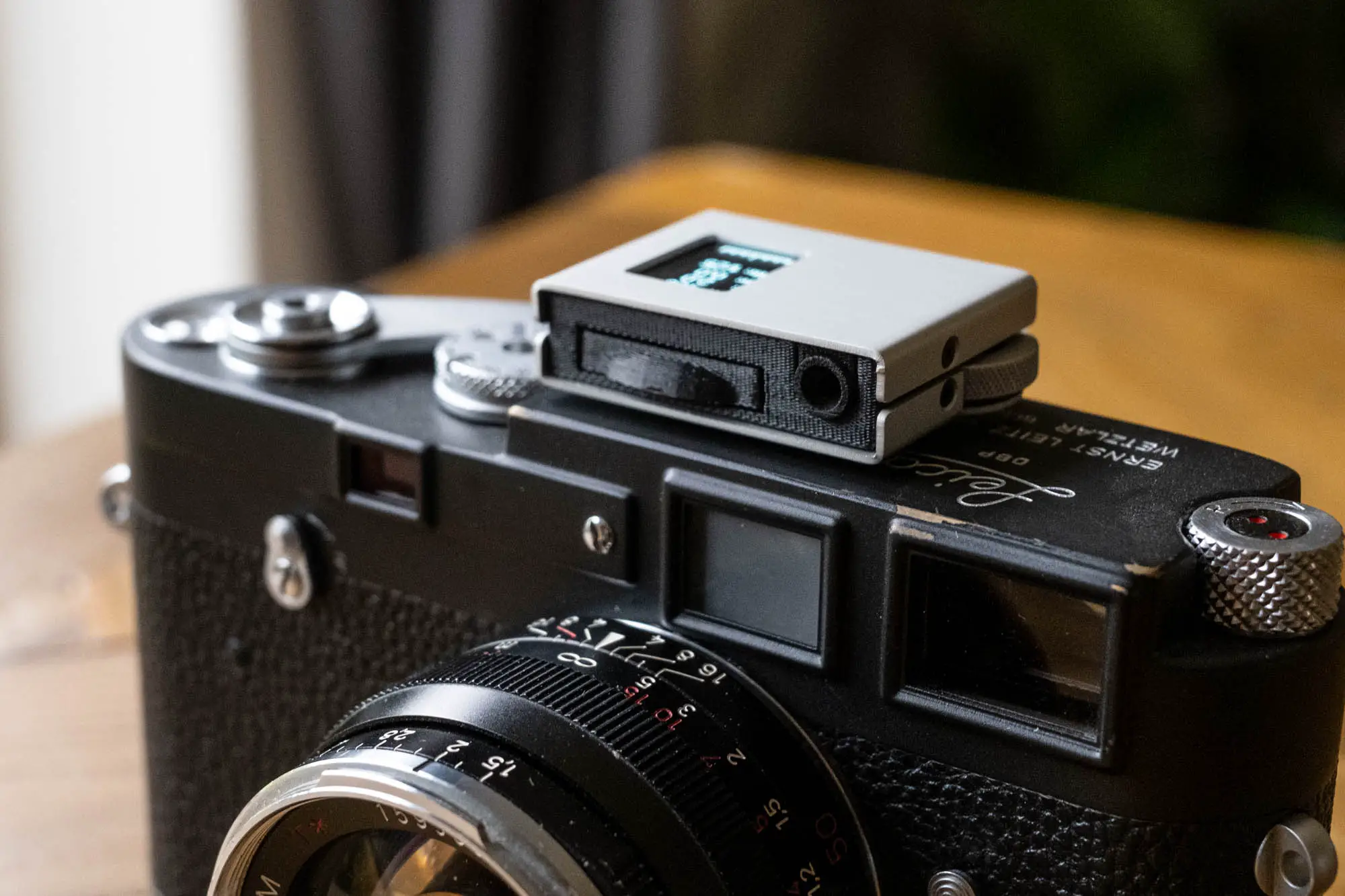
Pros
- Dial allows very fast setting
- Small and light
- Allows for user calibration
- Displays EV
- Exposure compensation mode
- Wide range of settings
- Range of mounting accessories
Cons
- Feels a little insubstantial for the money
- Readout letters/numbers quie small
- Discontinued (see Lime Two below)
For more details, you can find my complete review of the Hedeco here
Hedeco Lime Two
The Hedeco Lime Two is a polished and upgraded version of the first Lime One. It was also released at a more competitive price point than the previous version.
In terms of the upgrades over the previous version, the most obvious is the build quality. Whilst it is still very light – perhaps too light – the overall feel is much improved. Instead of it being made from 3d printed plastic and bend metal, it is now made out of CNC’d aluminium. The only 3d printed part is the battery tray, but even that has a aluminium face plate.
There are also a few tweaks to the improve the meter’s spec.
One feature I didn’t notice when using the first version was the manual metering mode. As I talk about in my review, I actually found this unique feature really compelling to use with my fully manual cameras.
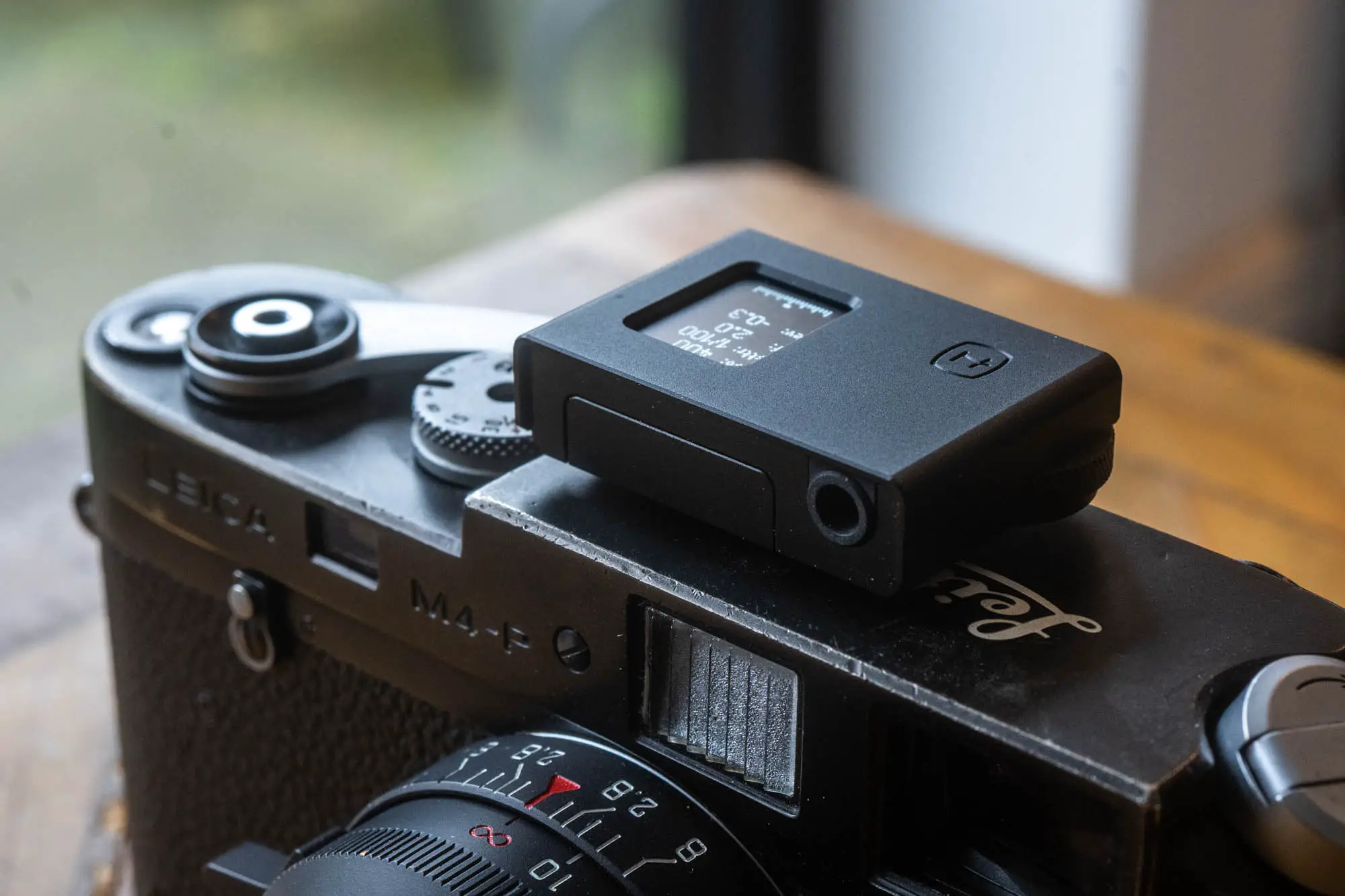
Pros
- Dial allows very fast setting
- Small and light
- Allows for user calibration
- Displays EV
- Exposure compensation mode
- Wide range of settings
- Manual mode really nice with fully manual camera
- Range of mounting accessories
- Price more compelling than first version
Cons
- Feels a little light weight
- Readout letters/numbers quite small
For more details, you can find my complete review of the Hedeco here
Doomo Meter D
Out of all the shoe mount light meters listed here, the Doomo Meter D is the one I wanted to love the most. It is to all intents and purposes a copy of the Voigtlander without the lines on the top to denote the reciprocal settings, but with the advantage of a better battery compartment that won’t randomly ditch the batteries and +/- shaped LEDs that make it easier to read.
Unfortunately, the two I’ve tried were slightly inaccurate to my eye. This is no real issue as it’s easy enough to just differently rate the meter to your needs, so for eg, I found myself rating 400 ISO film at 200 on the meter. I wouldn’t say it is even a full stop out, but it was enough out for me to want to make an adjustment. It’s also not user calibratable.
For all that though, the Doomo Meter D really is a very nicely made meter. The build quality is way up there – it’s easily as nicely made as the Voigtlander, and as I say has a better battery compartment.
Of course, it is still limited by the nature of the dials in terms of the range of settings compared to the OLED meters, but with that comes a more “analogue” user experience that some might prefer.
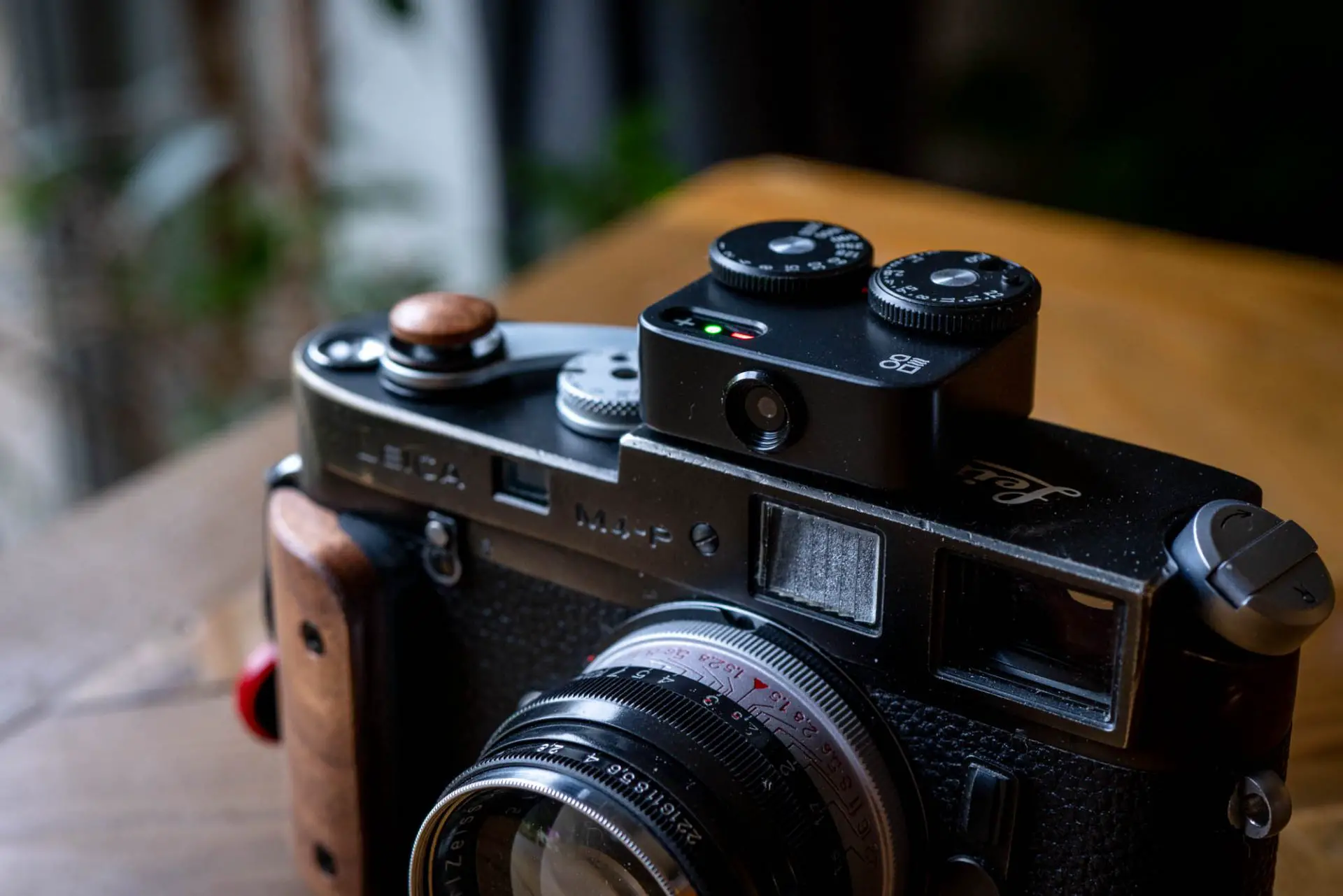
Pros
- “Analogue” dials will appeal to some
- +/- LEDs make for quick and easy to read user experience
- Solid build quality
- Half the price of the Voigtlander it’s a near-copy of
Cons
- Settings range limited by dials compared to the OLED meters
- Slightly inaccurate to my eye
- Slightly unusual battery type
For more details, you can find my complete review of the Doomo here
V-201x
The V-201x is the budget option of shoe mount light meters listed here, and with that comes some compromise. For my money, the build quality – especially of the metal version – is just ok. The housing around the controls and USB port doesn’t look particularly great, and it feels a little cheap. It’s also a bit clunky looking in terms of the design. Furthermore, the controls are a little sharp against the tip of your finger.
The ones I tried were also slightly inaccurate to my eye, and as well as that the intermediate aperture settings between f/2 and f/4 are a little out of whack – possibly I suspect due to some sort of rounding error. Switching between modes it remembers the last setting too, which might sound logical, but in practice provided a strange user experience.
For all that though, it is cheap, and I quite like the fact that it has a built in battery and can be charged off a USB-C cable which are becoming fairly ubiquitous.
Personally, this meter is my least favourite of the bunch, but it’s still a workable option for those with a tight budget.
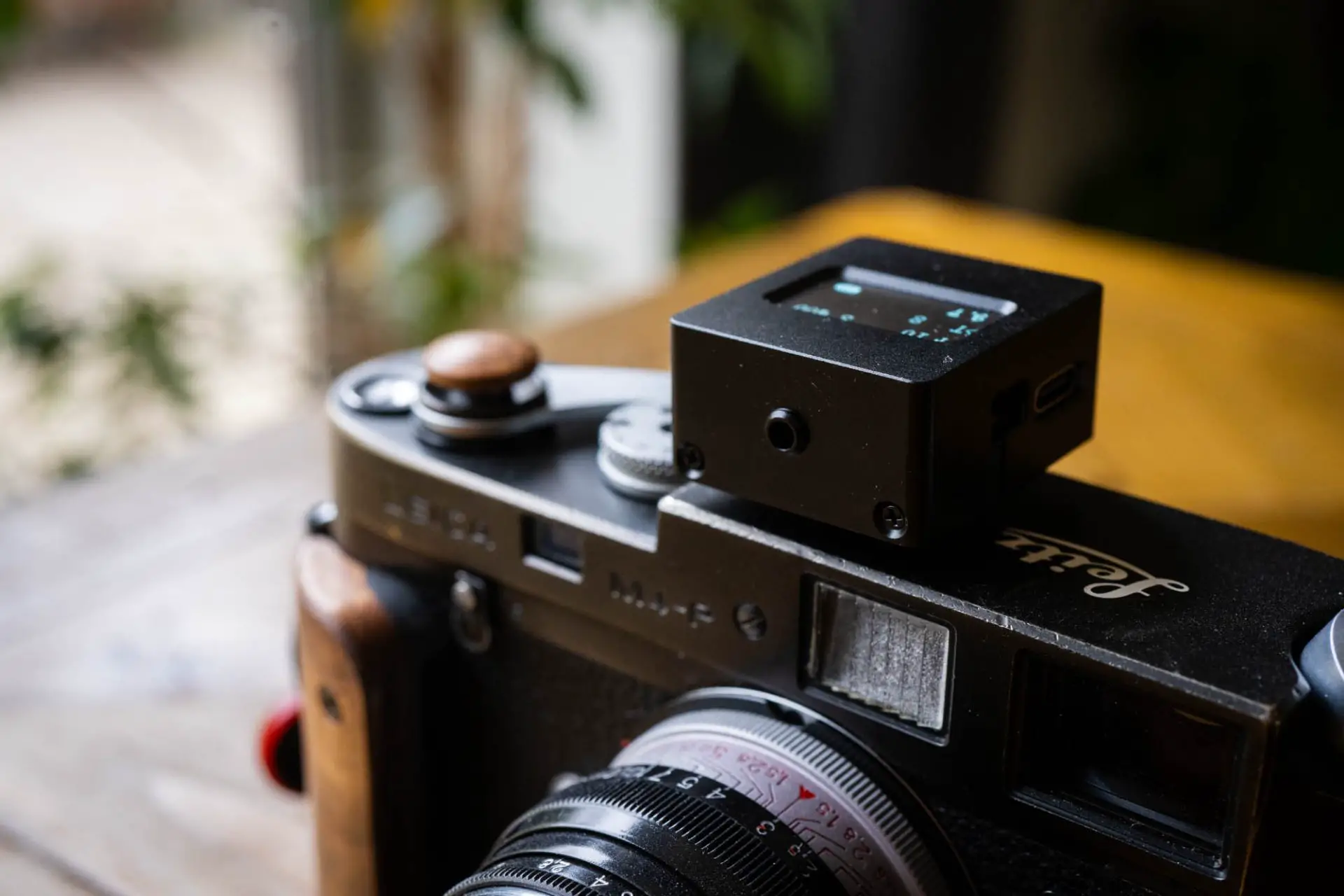
Pros
- The cheapest of the bunch here
- USB-C Rechargeable
Cons
- Strange aperture settings
- Strange user experience
- Clunky design
- Sharp buttons
- Built in battery will eventually fail
- All of the other meters here have stronger and more obvious pros for not that much more cash
For more details, you can find my complete review of the V-201x here
Keks EM-01
The Keks EM-01 was (edit: at one stage) the last of the shoe mount light meters I reviewed, but one of the first I was aware of. I always thought it looked a little bulky on cameras when I saw pictures of it, and this was born out when I played with one in real life too.
But, that was pretty much the only thing I found I didn’t really like about it, short of it being a little slow to use, but even that was only in comparison to the Hedeco.
Unlike the Hedeco and Reveni it also doesn’t offer any user calibration options. This wasn’t an issue in practice though as the one I tried was bang on accurate – to my eye at least.
The 4 buttons on the top make for a really logical user experience.
The factor that really gave me a bit of added confidence in it was the build quality though. Just like the Doomo, it feels really solid and well made. It also comes with a range of slightly different sized screw on shoe mounts meaning it can be well fitted to your camera.
Overall, the Keks was the OLED based meter that I like the most.
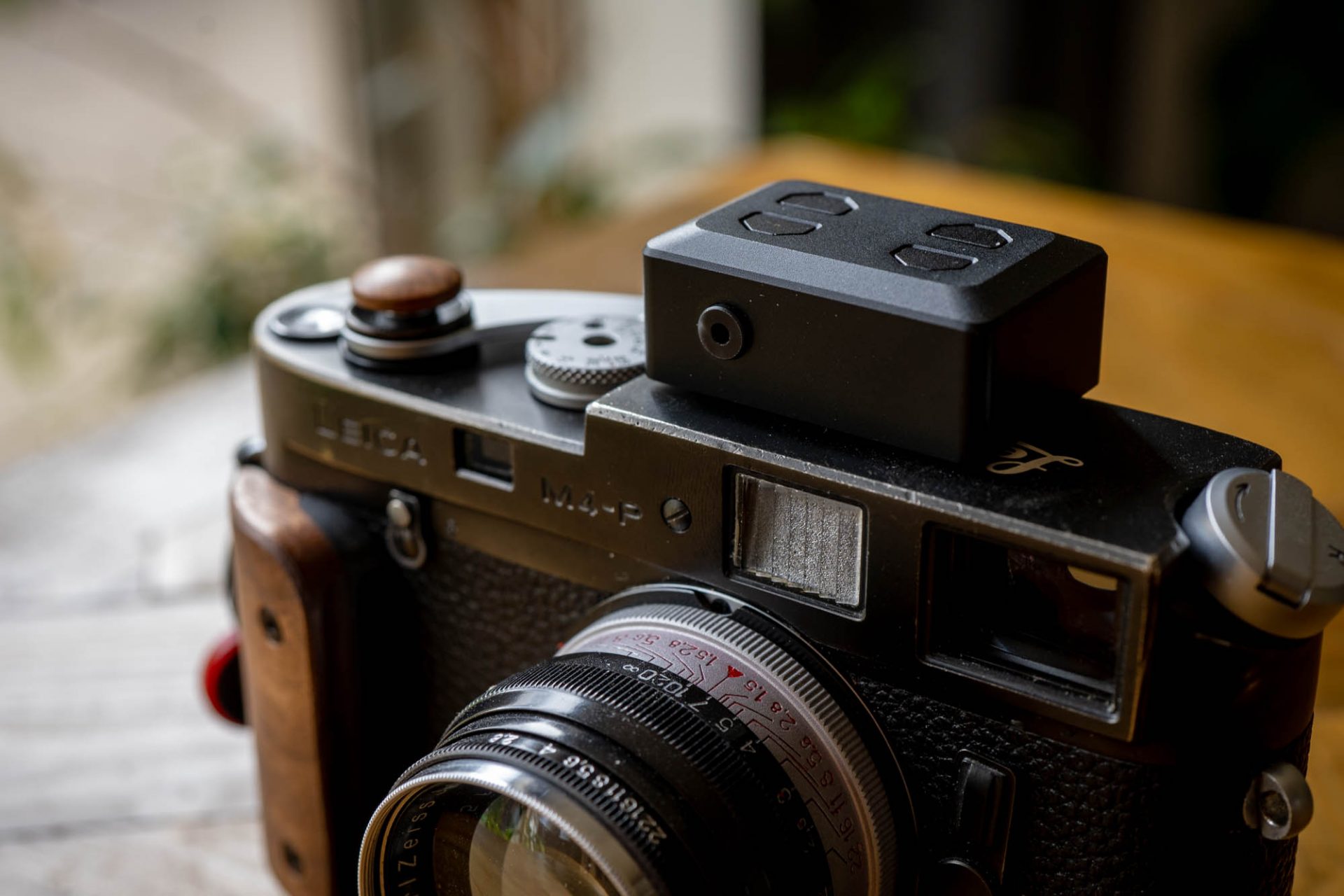
Pros
- Really nice build quality
- Logical user interface
- Accurate
- Displays EV and Lux alongside shutter and aperture readouts
- Range of shoe mounts in the box
- USB-C Rechargeable
Cons
- Not as quick to use as the Hedeco
- A little bulky
- No user calibration (though is accurate out of the box)
- Built in battery will eventually fail
For more details, you can find my complete review of the Keks here
Doomo Meter-S
The Doomo Meter S is an addition to this article since I first wrote it. It’s actually become a little bit of a favourite. It’s nice and small, feel solid and has a simple user interface, at least once you get used to it.
The Meter S takes little bits from each of the other meters I have reviewed to make a fairly well rounded package that will definitely be compelling to some – including me. I like the fact it has an internal battery. For some, this might be a deal breaker. I quite like the fact that it is simple and comes without potentially superfluous modes. Others will prefer the more feature packed meters. I also like the simplistic one button/one dial controls. Others might not. Finally, I also really like the build quality, though I might like it slightly more if it had a slightly lower profile.
Ultimately, the Doomo Meter S – despite not having a specific USP – does offer a unique set of features and functionality that sets it apart from its competitors. It might not be to everyone’s taste, and there are a few little things about it that aren’t perfect, but if it was my only shoe mount meter, personally, I’d be very happy with it!
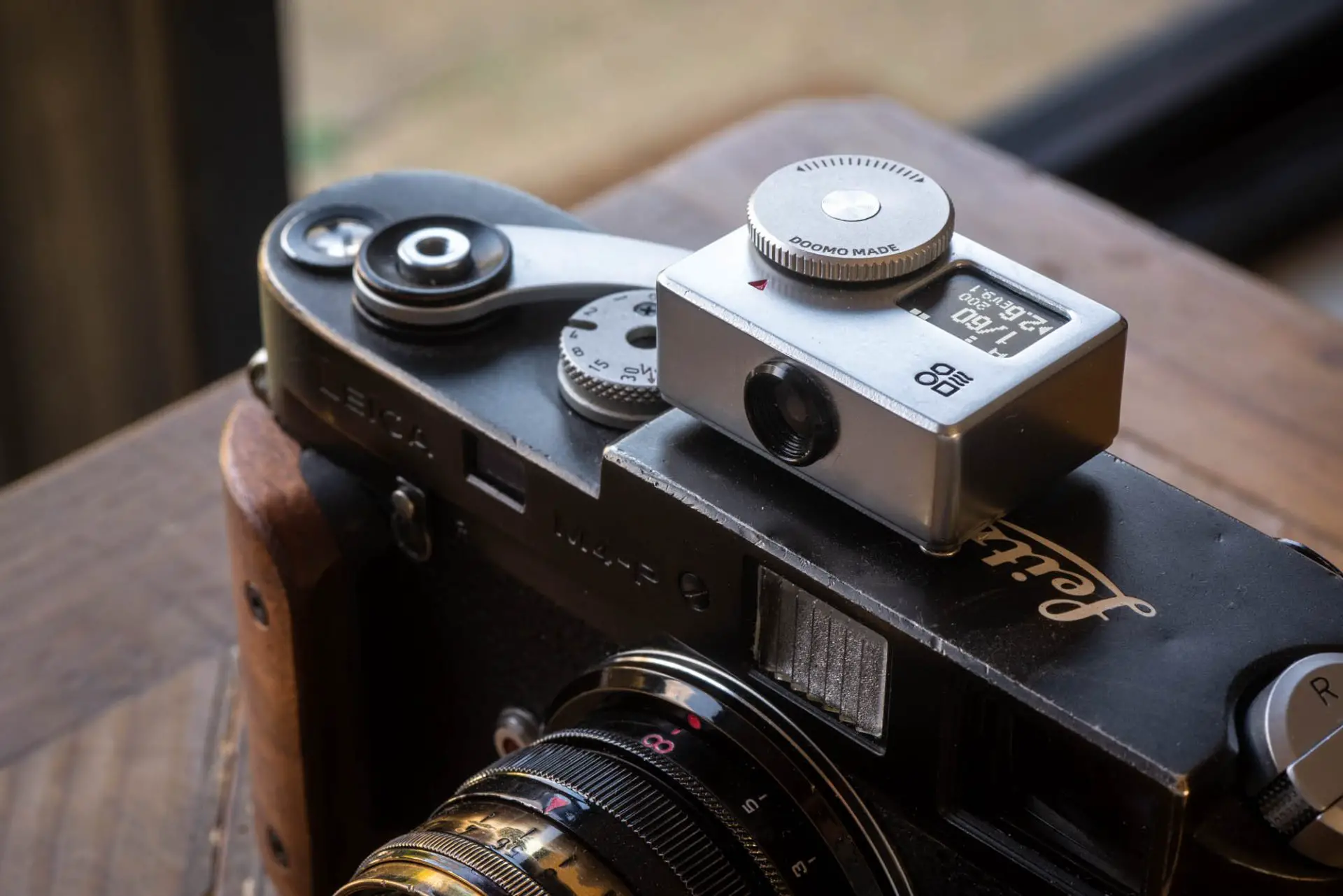
Pros
- Really nice build quality
- Logical user interface (once you get used to it)
- Accurate
- Range of shoe mounts in the box
- USB-C Rechargeable
Cons
- Not as quick to use as the Hedeco
- No user calibration (though is accurate out of the box)
- Built in battery will eventually fail
For more details, you can find my complete review of the Doomo Meter S here
Keks KM02
Like the Keks EM01, the Keks KM02 appealed to me greatly. The build quality is just as nice as the first light meter, and the user experience arguably just as logical, and that’s despite the addition of a whole host of features. In fact, it is the additional features such as the ability to customise the meter to match the setting on your camera and/or lens and other customisations that really set it apart from the crowd.
It is a little slower to use in comparison to the Hedeco, and if being super picky I might have preferred it if the customisation options were a little less in-depth. But, overall, thanks to the combination of features, customisation options, acuracy, quality of build, built in battery and user experience, for me the Keks KM02 overtakes the earlier model as the OLED based meter that I like the most.
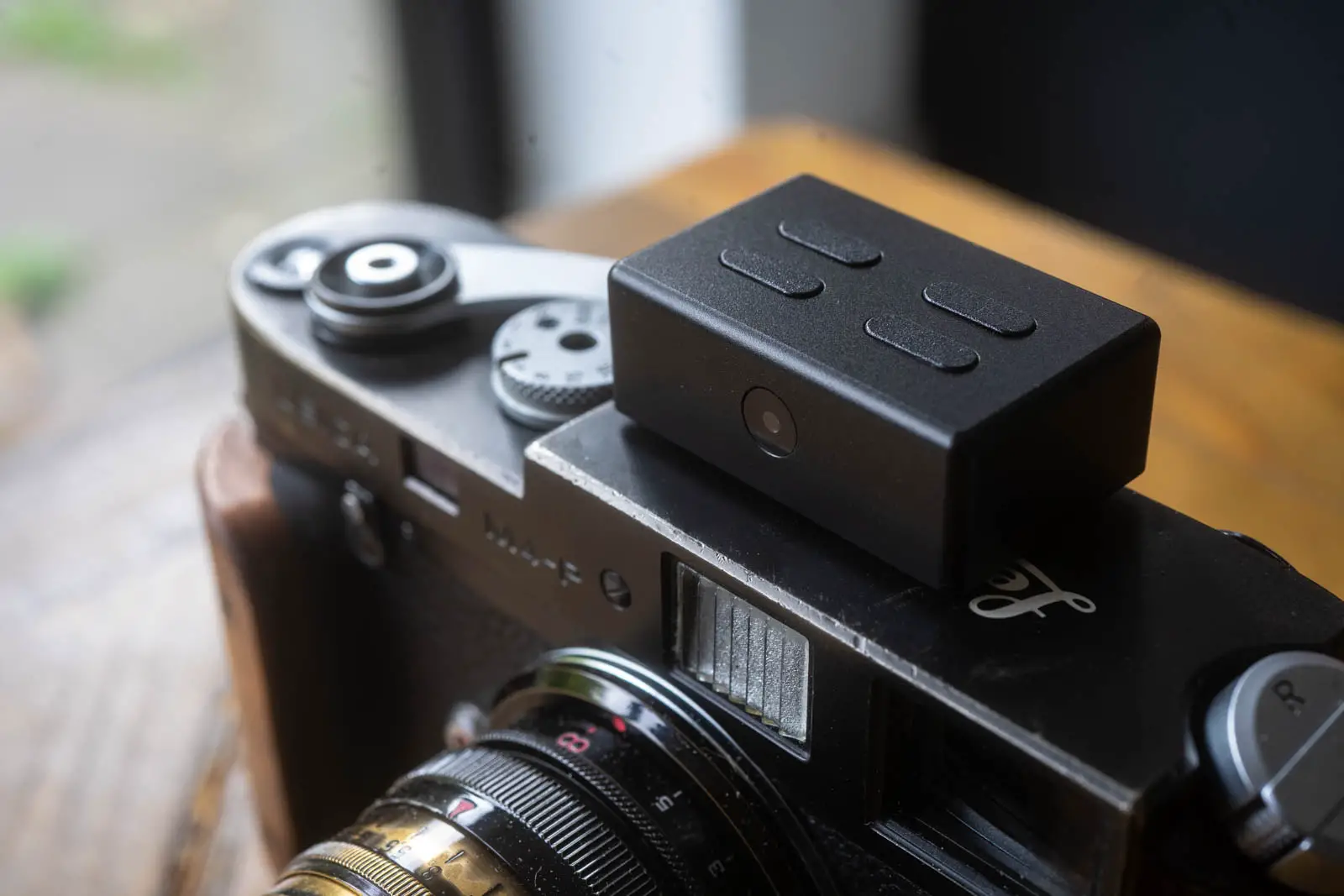
Pros
- Really nice build quality
- Genuinely useful customisation options
- Logical user interface
- Accurate
- Displays EV and Lux alongside shutter and aperture readouts
- Range of shoe mounts in the box
- USB-C Rechargeable
Cons
- Not as quick to use as the Hedeco
- Built in battery will eventually fail
For more details, you can find my complete review of the Keks here
Reflx Lab Light Meter
I like the Reflx Lab Light Meter. I like it more than I thought I might. It has some foibles, but those are readily offset by the low price, nice build quality and smaller size. For some, the button cell battery will be a big factor too. Overall, I think it represents really good value.
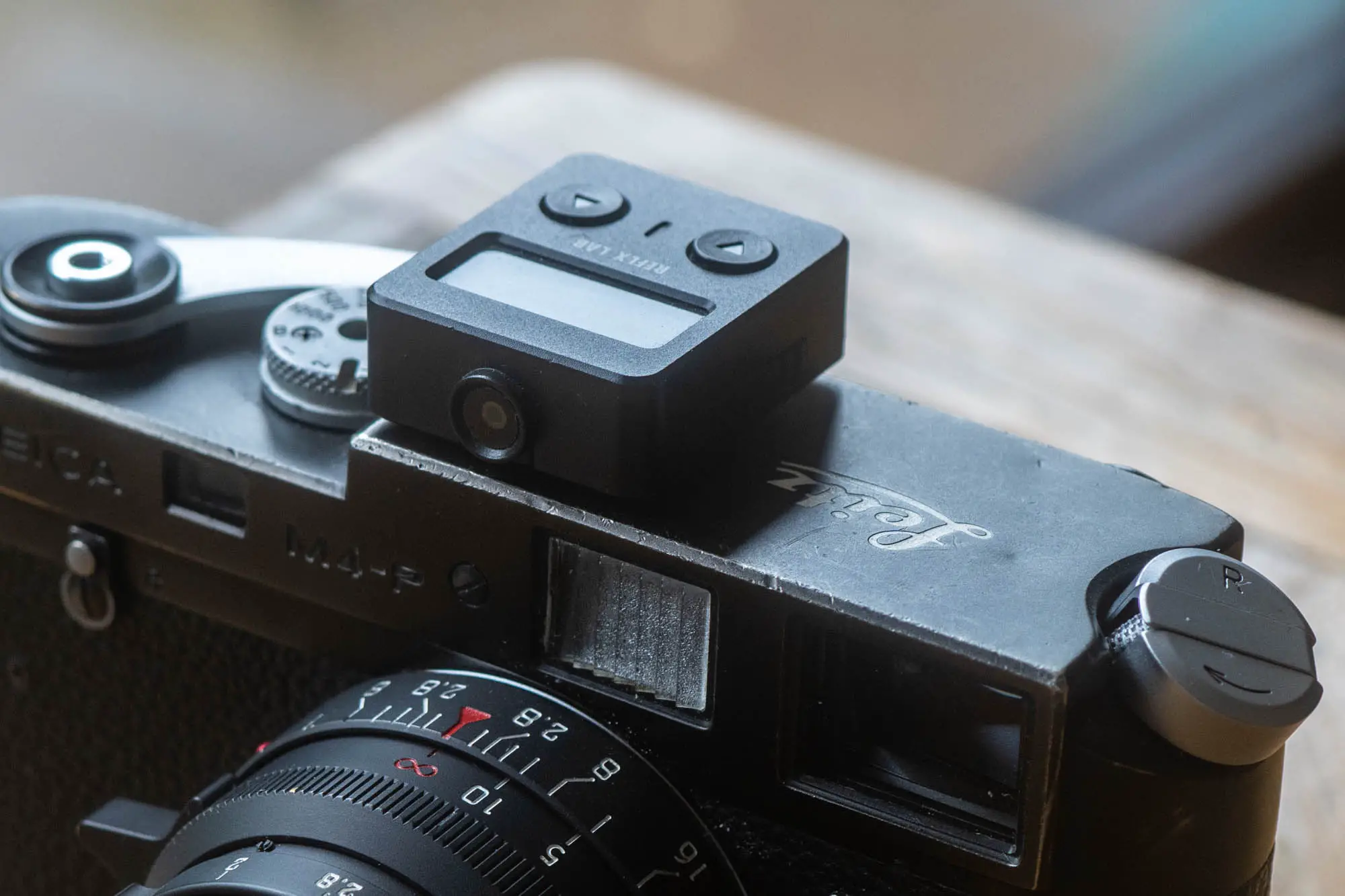
Pros
- Nice build quality
- Accurate
- Small size
- Button cell battery for those who prefer one
Cons
- Some readout and settings peculiarities
- Potentially difficult to see screen
Read the full review here
Astrhori AH-M1
I quite like this Astrhori AH-M1. It’s similar to the Doomo meter S but has a slightly more intuitive user interface. I also really like the implementation of how it switches between constant and single metering modes. What’s less appealing is the fact that even after it has been updated, it still has a slightly tweaky dial that can sometimes make for settings that jump about a bit. That said, it’s worth noting that it is not a particularly expensive meter, and for the money – if you can cope with the sometimes wonky dial – it strikes me as pretty good value.
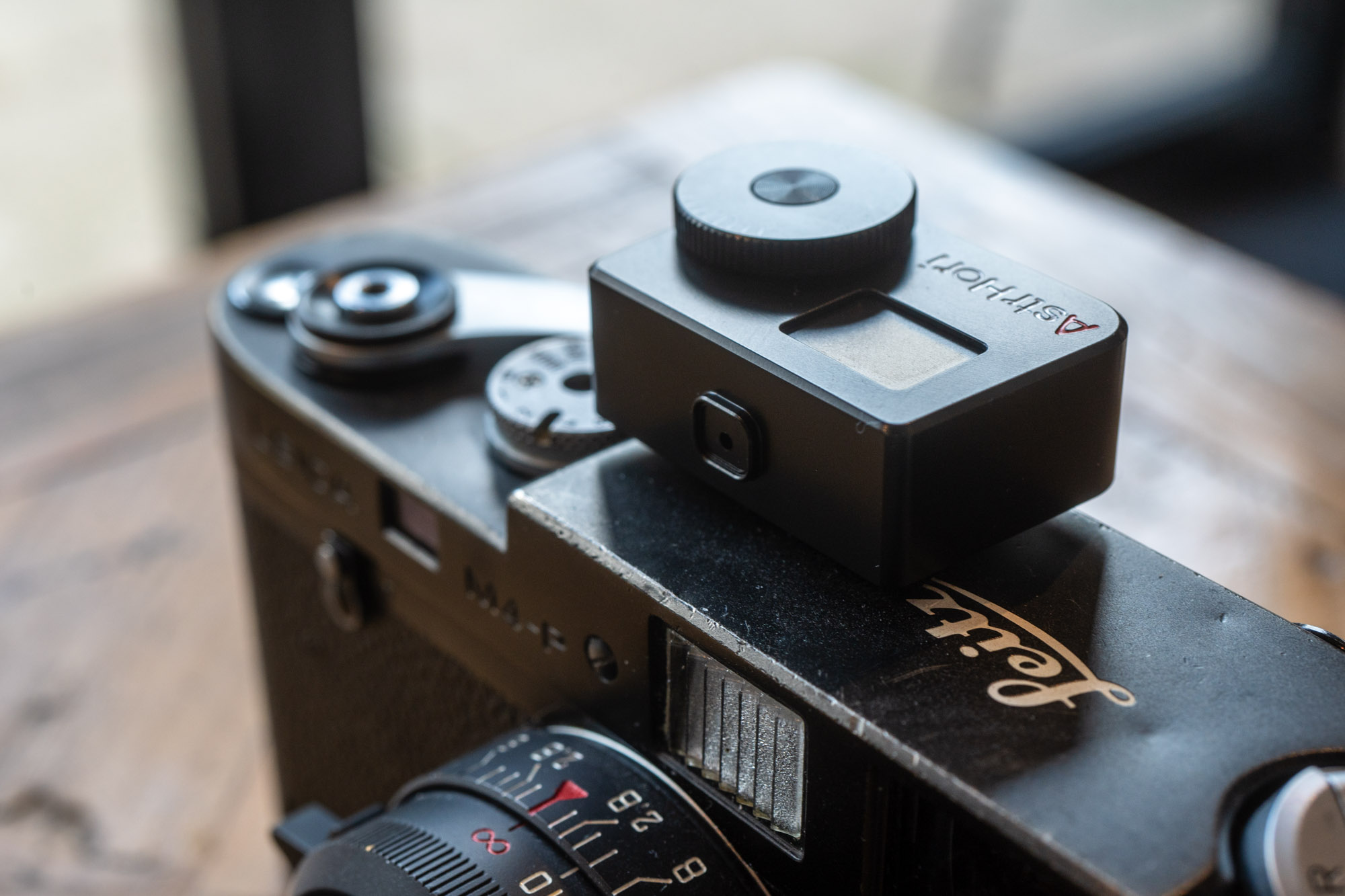
Pros
- Nice build quality
- Accurate
- Quick to use
- Easy to switch between constant and single meter readings
Cons
- Dial can sometimes flick between settings incorrectly
- Built in battery will eventually fail
Read the full review here
Astrhori XH-2
Despite the weird shape I like the Astrhori XH-2. It has the same features and functionality as the AH-M1, but at least in the case of the copy I have here actually works properly and did so first time round. I’m not sure its design perfectly lends itself to being mounted on cameras like my Leica, but I did make it work for me, and I do think it will work very well on some cameras where mounting space is limited. I also think in that context, it is a nice effort at making a design that will fit on more different designs of camera, without just resorting to making it smaller and more fiddly to use. In a crowded market of shoe mount meters, it is nice to see a different approach to design. It’s just a shame they didn’t include a little hole for attaching a lanyard – that would’ve rounded it off nicely for me!
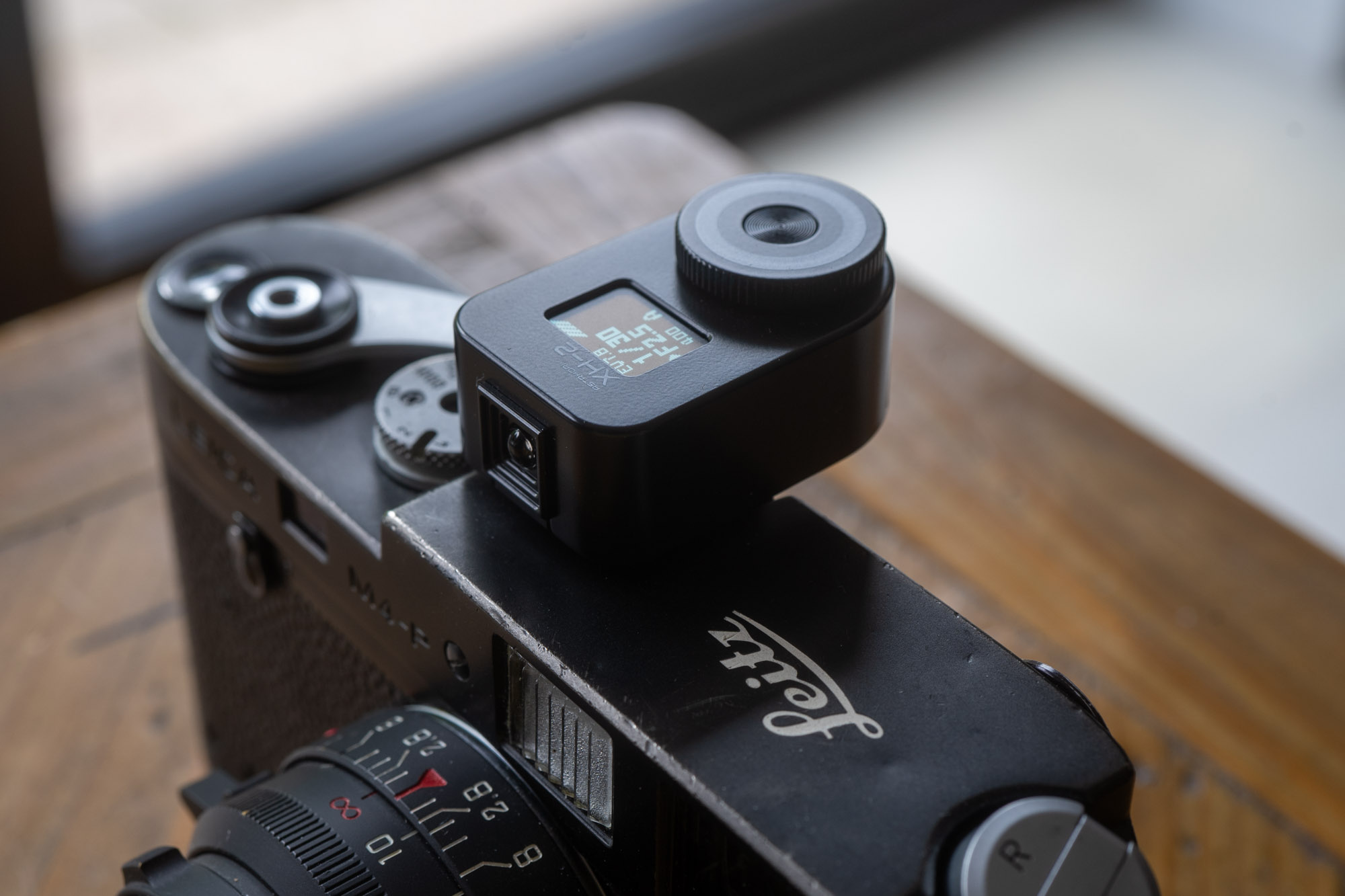
Pros
- Nice build quality
- Can fit on some cameras where the odd shape makes for a better fit
- Accurate
- Quick to use
- Easy to switch between constant and single meter readings
Cons
- Very odd shape
- The lack of loop to attach a lanyard to it just seems like a massive missed opportunity
- Built in battery will eventually fail
Read the full review here
Keks KMQ
The Keks KMQ isn’t my favourite shoe mount meter, but that’s definitely not to say that I don’t see the merit in it – it’s just not for me. I also really liked the Reveni when it first came out, and I think the Keks is overall a better meter due to its slightly nicer build quality and easier to press buttons. This issue for me is that I just don’t need a meter to be this small. As such, in use, I feel like I am just working against the compromises that the smaller size brings. Of course, if you have a camera that this meter will suit – a camera that no other meter will fit on, then it is hard to argue with the advantages it brings. Just like the Reveni, the Keks KMQ answers the question of the need for a tiny meter, but it does it in a way that feels more robust, arguably looks nicer on the camera and has buttons that are easier to press.
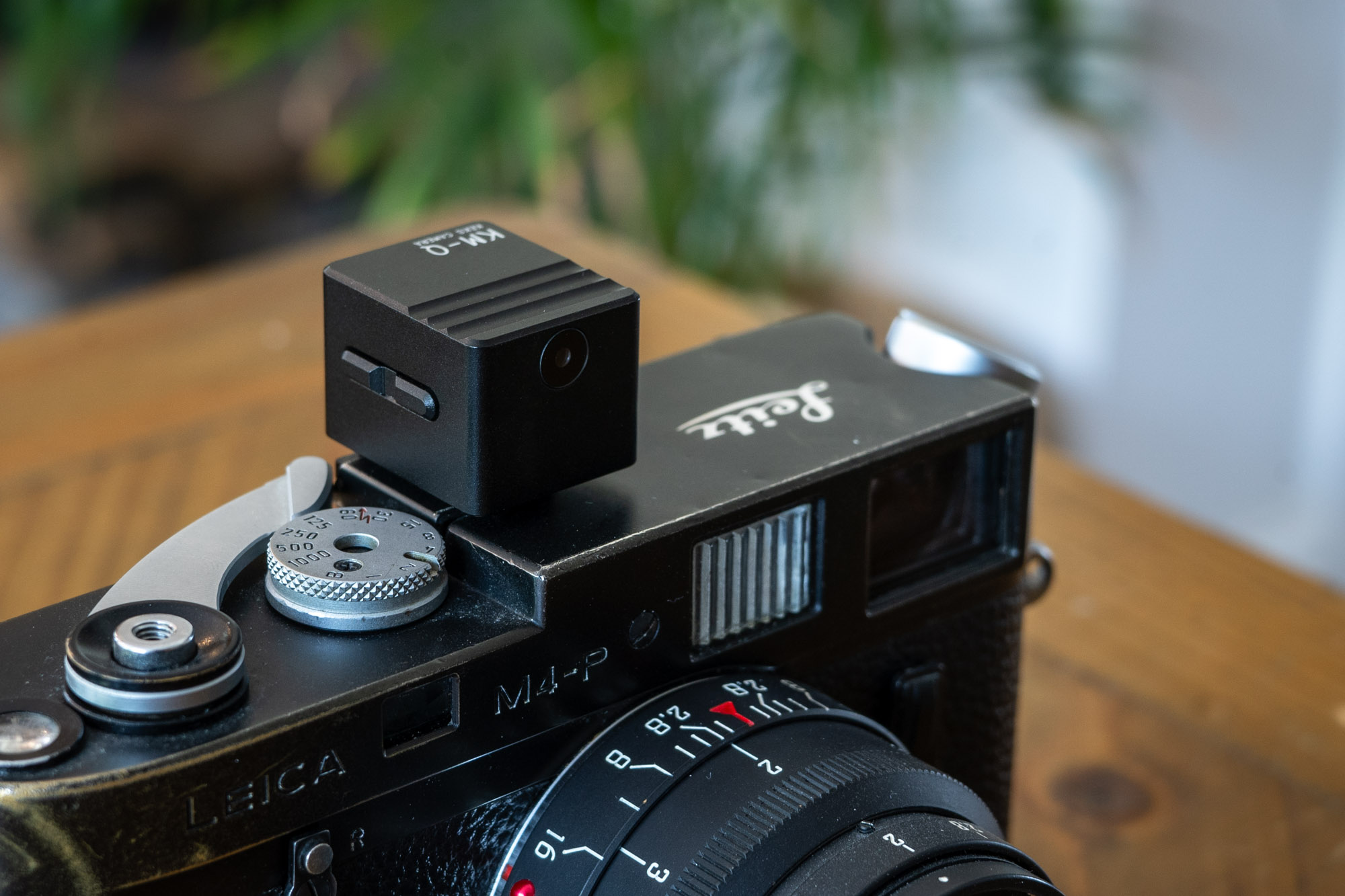
Pros
- Nice build quality
- Great for cameras other maters don’t fit on
- Accurate
Cons
- Small
- Fiddly to use
- Built in battery will eventually fail
Read the full review here
Sekonic Twinmate L-208
I really like the Sekonic Twinmate L-208. It is a very basic meter with nothing in the way of superfluous frills, and isn’t going to be particularly useful in low-low light. It has no functionality for flash photographers and some will find its light weight plastic build off putting I’d imagine – especially if you hold it up against classic meters such as the Weston Master 5. What it does bring to the table though has been pretty compelling for someone who works like I do. I have spent the last few years fiddling with shoe mount meters mostly for their tiny size. I’m the type to supplement guess work with a meter rather than metering for every shot. I also don’t like carrying too much kit around with me. So having something so small that it practically disappears into a pocket or can be mounted on a camera high on my priority list. The Sekonic Twinmate L-208 fits that bill, but adds practicality, both incident and reflective metering and a meter readout that I enjoy working with. In short, I think this is great light meter, and having reviewed it, I now own one and I believe it is going to get a lot of use!
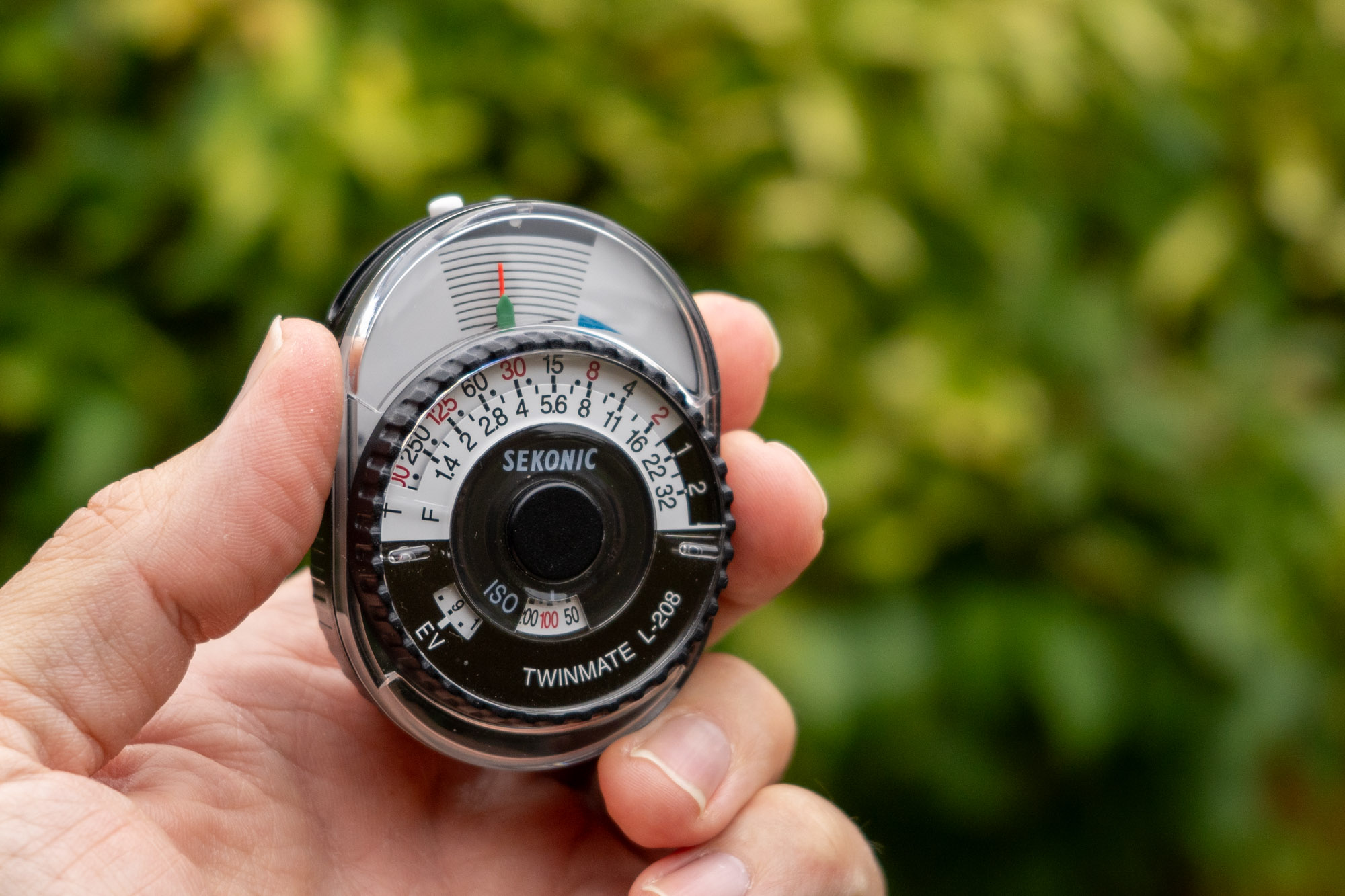
Pros
- Nice, albeit plastic build quality
- Reflective and Incident metering
- Easy to read and use
- Accurate
- Battery life reputedly very good indeed
Cons
- Big when compared to other meters in this list
- ISO dial can get knocked (I didn’t notice this, but many report it)
Read the full review here
Light meters not reviewed by me
Below are a couple of the shoe mount meters that I haven’t reviewed
TTArtisan Light Meter
I didn’t personally review this meter, but i thought I would add it here for the sake of completion.
According to Frankie who reviewed it, it’s well made, but suffers an issue of accuracy with many people (including Frankie) finding it to be a 1-2 stops out.
Despite this, Frankie still thinks it offers good value for money as it is not very expensive at all.
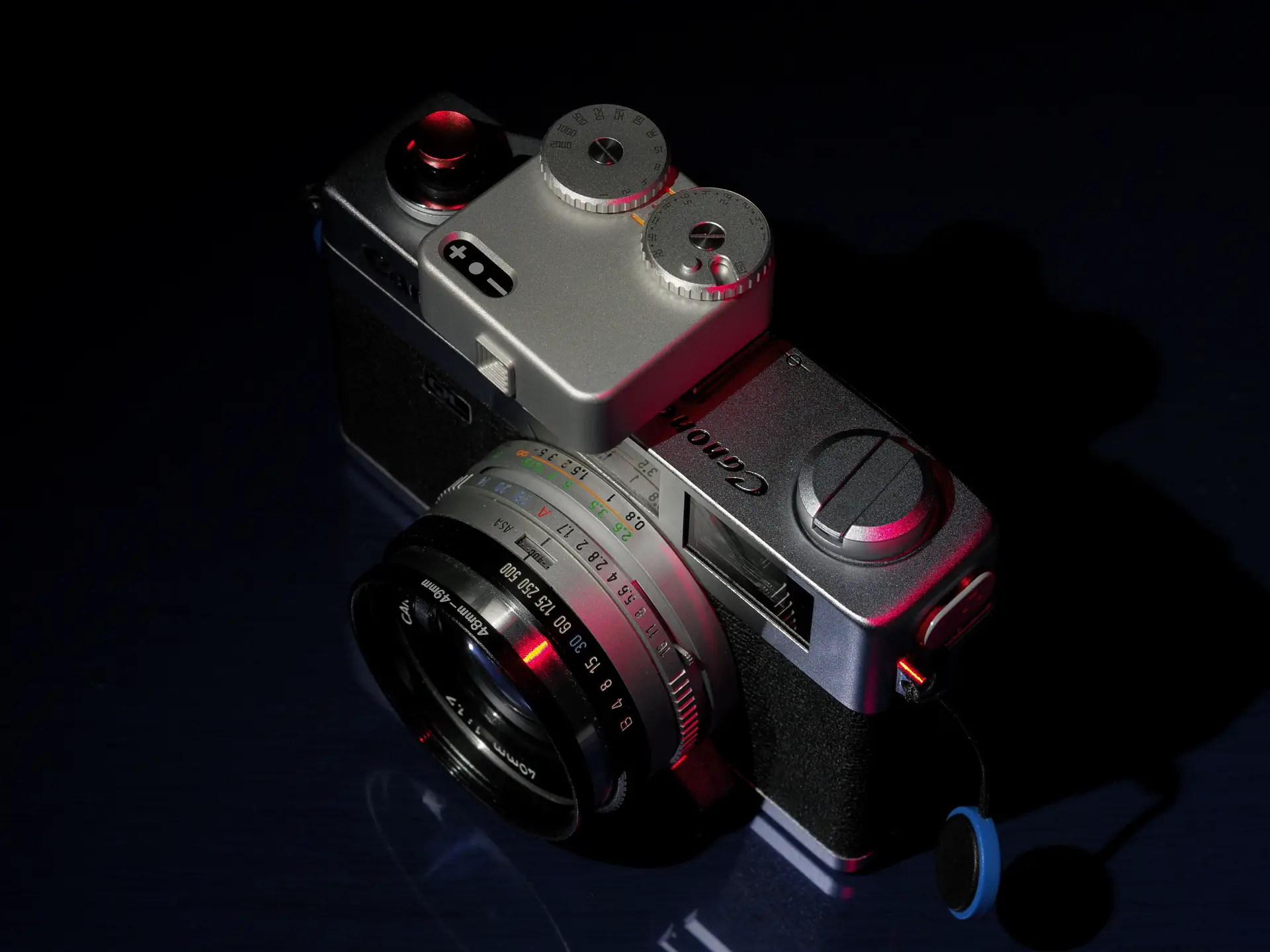
Pros
- “Analogue” dials will appeal to some
- +/o/- LEDs make for quick and easy to read user experience
- Solid build quality
- A fraction of the price of similar meters
Cons
- Settings range limited by dials compared to the OLED meters
- Many users report that it’s inaccurate
For more details, you can find my complete review of the TTArtisan meter here
TTArtisan Light Meter
Again, I didn’t personally review this meter. According to Frankie who reviewed it, it is a step up from the first version of this meter both in terms of its smaller size and greater accuracy.
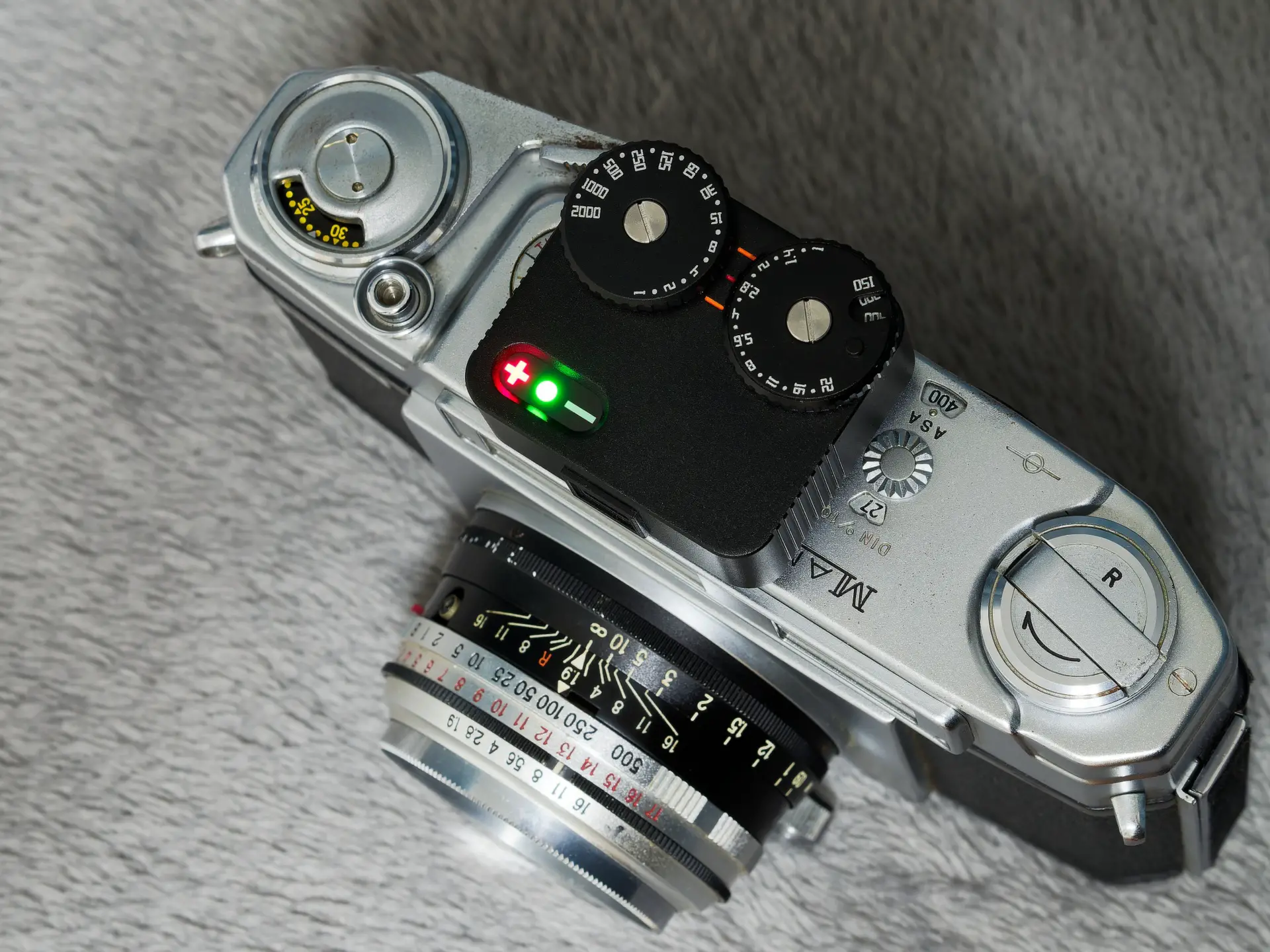
Pros
- “Analogue” dials will appeal to some
- +/o/- LEDs make for quick and easy to read user experience
- Solid build quality
- A fraction of the price of similar meters – the cheapest of this type of design.
- More accurate than first version
Cons
- Bright light can impact accuracy
- ISO dial spins freely and can be knocked
For more details, you can find my complete review of the TTArtisan meter here
Final thoughts/My opinion
There are a couple of other shoe mount light meters out there – one of them being the ZB_M08 which is even cheaper than the V-201x, but looks a little naff. I might get around to writing about it, but to be honest unless someone gets in touch with me to tell me that it suffers none of the issues I found with the V-201x, I feel somewhat disinclined to try it.
All of the rest of the meters here are around £100, with the exception of the Hedeco and the Voigtlander which is a good bit over £200. If I were in the market for one of these types of meter, I personally would ignore the cheaper meters and would stretch to at least the ~£100 meters.
If you can do so, this rules out the ZB_M08 and V-201x. If you like the more “analogue” controls, and can get over the slight inaccuracy then go for the Doomo Meter D. If you want a more accurate meter, and can swallow the price (and potential issue of the batteries falling out), it’s the Voigtlander.
If you like the idea of an OLED meter with the wider range of setting they bring to the table, then go for the Reveni if you want the absolute smallest, the Hedeco for speed and the Keks KM02 for overall build quality and range of feature. Whichever one you go for though, I would still advise reading my full reviews listed above where I go into a little more detail.
Please feel free to add your thoughts to the comments below if you think they will help someone decide which to go for.
You can also find more reading related to these sorts of light meters in this excellent article by Joerg-Peter Rau on my mate Mike’s website, Macfilos
Share this post:
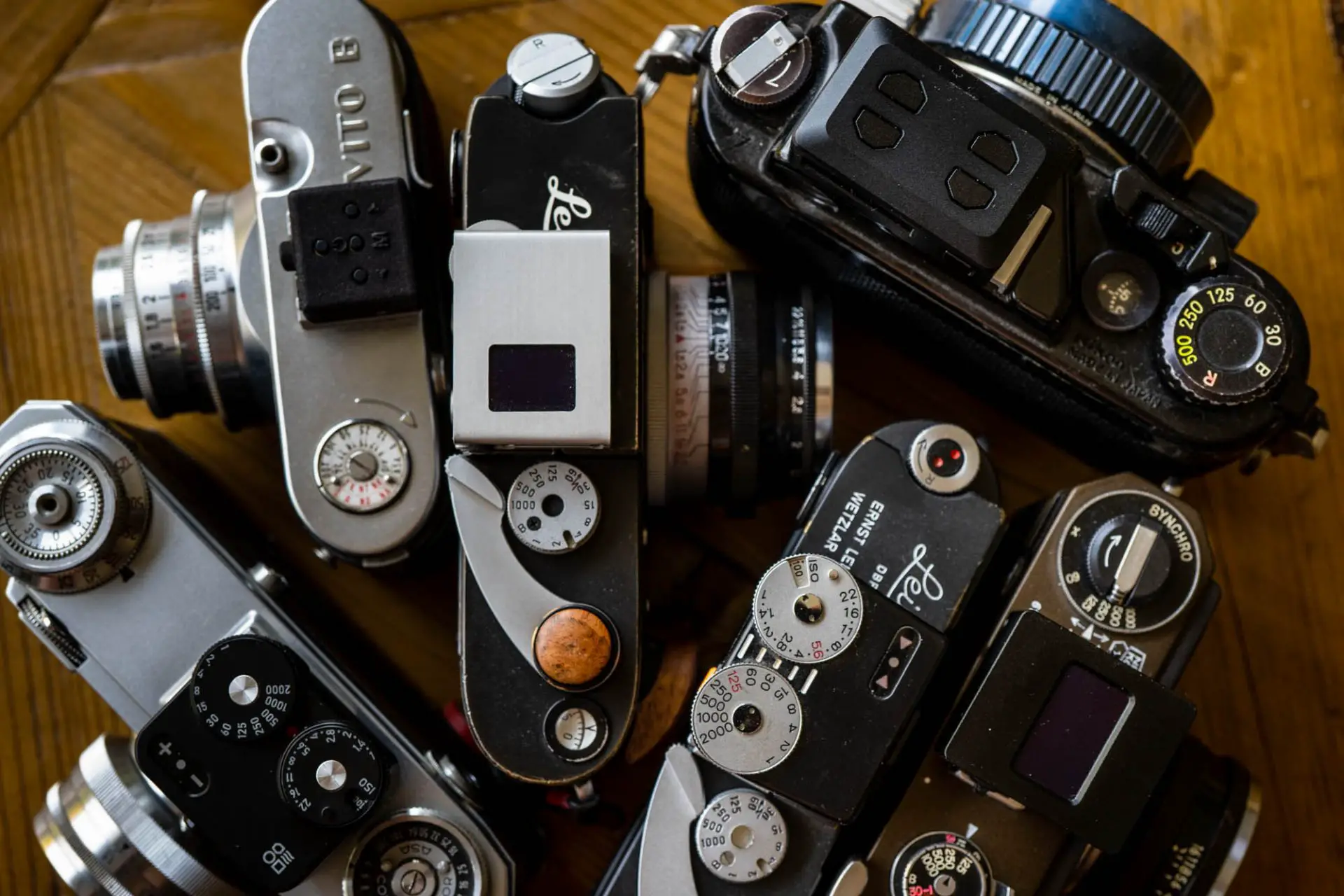
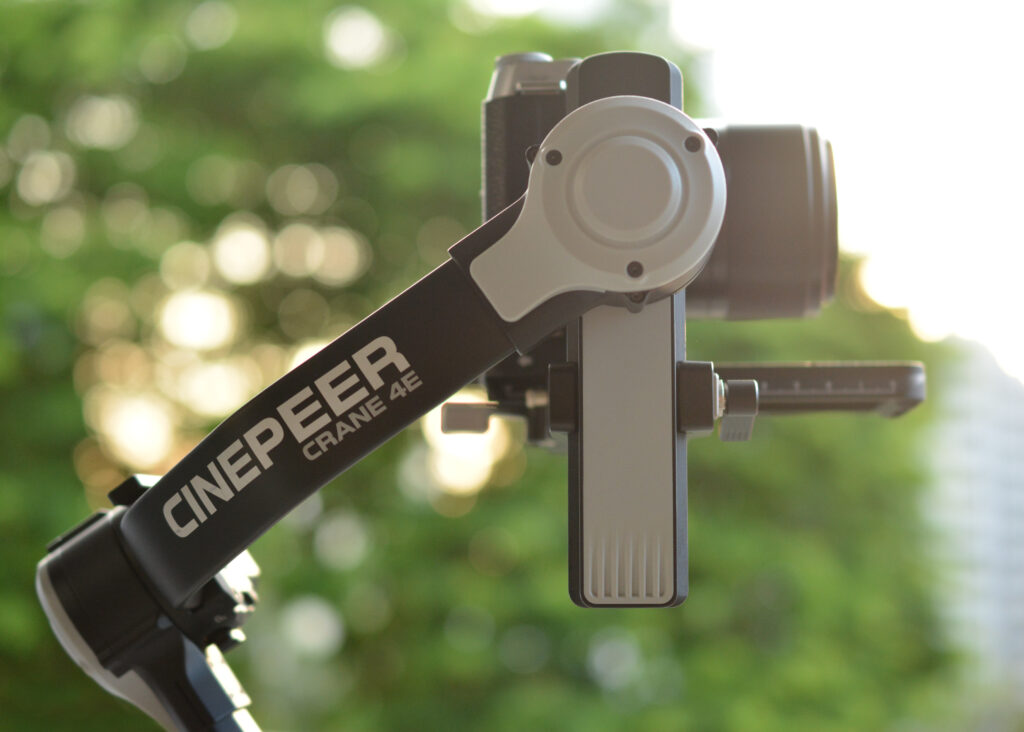
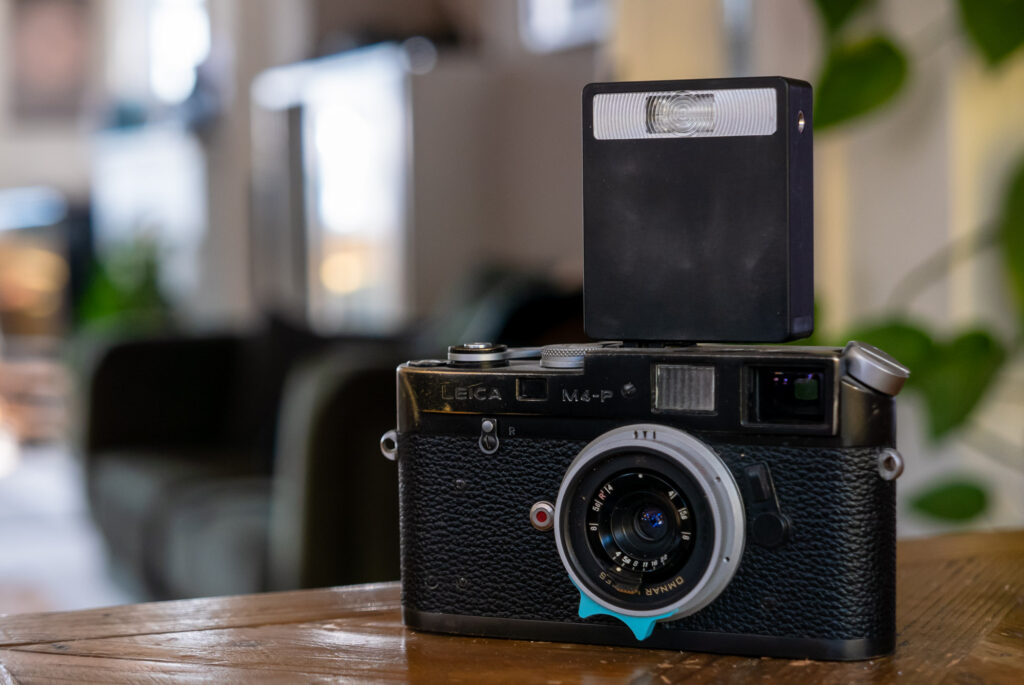
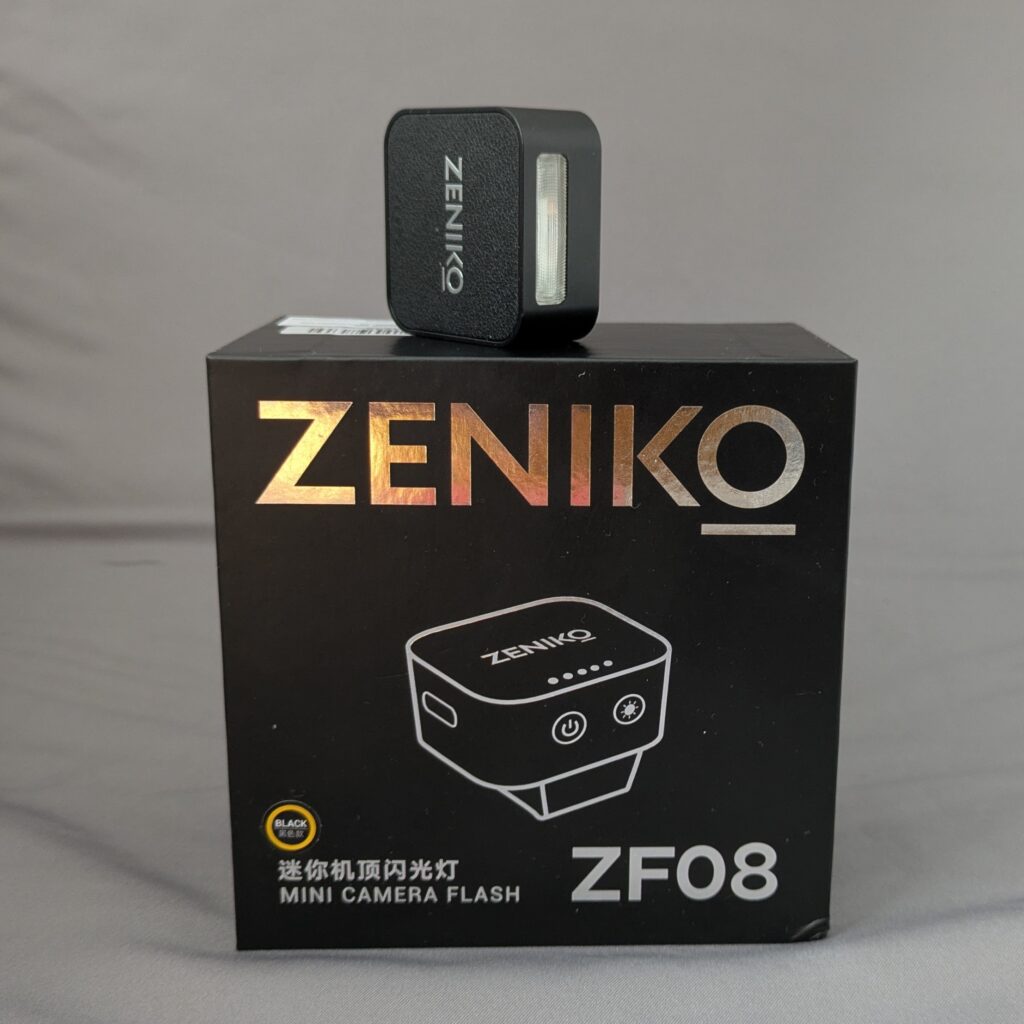




Comments
Jeremy on Shoe Mount Light Meters – Which One is Right for You…?
Comment posted: 03/05/2021
Comment posted: 03/05/2021
Paul on Shoe Mount Light Meters – Which One is Right for You…?
Comment posted: 03/05/2021
Nice article. Thanks for the valuable info
One remark: the link to the Hedeco does not refer to the Hedeco.
with kind regards
Paul
Comment posted: 03/05/2021
Case Harris on Shoe Mount Light Meters – Which One is Right for You…?
Comment posted: 03/05/2021
Obviously one’s personal approach to logic varies wildly. I’ve found the Keks meter nearly unusable because of so many buttons affecting things in such a non-intuitive way. As a novice at using meters that aren’t built in to a camera, I was able to begin using the Reveni meter right out of the (tiny) box.
One minor correction, is that the Voigtlander VCii is available new (albeit many dollars for a tiny little device) from a variety of photo-related online retailers (B&H, Adorama, CameraQuest, etc.) I just received mine from Amazon (USA).
Comment posted: 03/05/2021
Leo Tam on Shoe Mount Light Meters – Which One is Right for You…?
Comment posted: 03/05/2021
Comment posted: 03/05/2021
Phil Steelandt on Shoe Mount Light Meters – Which One is Right for You…?
Comment posted: 03/05/2021
I always trusted the Seconic light meters. I still use my 40 years old "Studio Deluxe" (great for incident metering) and purchased recently the L-858D to use with flashes and also as spotmeter.
One year ago I was looking for a small shoe mount light meter to mount on my old rangefinders.
I was tempted by those 3D printed ones and by the Voigtlander.
I decided to go for the small Sekonic Twinmate L-208...Okay, it's a uggly plastic little duck that spolils the look of my old Contax, Leicas or FSU-rangefinders ;-)
But it's an alternative to consider.
It's an very accurate old school meter with analog reading, easy to use in both incident (it has a tiny retractable "dome" for it) and in reflected mode.
I checked its measures with my two other Sekonics ad it's pretty accurate for such a small meter.
Just press the button, (the needle stays there for approx 15 sec) align the two needles and read the EV or the whole range of aperture/speed...that simple.
Comment posted: 03/05/2021
Comment posted: 03/05/2021
Peter on Shoe Mount Light Meters – Which One is Right for You…?
Comment posted: 04/05/2021
Comment posted: 04/05/2021
Chris Bennett on Shoe Mount Light Meters – Which One is Right for You…?
Comment posted: 04/05/2021
As you were previously recommending the Voigtlander VCii as a second-hand only option, you shouldn't overlook the original VC-meter. Apart from the lines that connect the values on the dials, it is functionally identical to the VCii, but with one big difference that you should approve of. It has a proper battery housing cap in the same vein as one finds on the bottom of a camera - an aluminium disc with a coin slot to open/close it.
Comment posted: 04/05/2021
JK_Foto on Shoe Mount Light Meters – Which One is Right for You…?
Comment posted: 04/05/2021
Comment posted: 04/05/2021
Lee on Shoe Mount Light Meters – Which One is Right for You…?
Comment posted: 04/05/2021
Eric Norris on Shoe Mount Light Meters – Which One is Right for You…?
Comment posted: 06/05/2021
I have a silver KEKS meter mounted on top of my Leica M4, where it looks very nice.
Duncan G on Shoe Mount Light Meters – Which One is Right for You…?
Comment posted: 23/06/2021
Lars on Shoe Mount Light Meters – Which One is Right for You…?
Comment posted: 20/07/2021
Comment posted: 20/07/2021
Comment posted: 20/07/2021
Comment posted: 20/07/2021
Martin on Shoe Mount Light Meters – Which One is Right for You…?
Comment posted: 15/02/2022
Martn on Shoe Mount Light Meters – Which One is Right for You…?
Comment posted: 15/02/2022
Do I need to buy a light meter for film photography? on Shoe Mount Light Meters – Which One is Right for You…?
Comment posted: 21/09/2022
HEDECO, Leica, Voigtländer, TTArtisan, KEKS: five attachable light meters on Shoe Mount Light Meters – Which One is Right for You…?
Comment posted: 21/11/2022
Hoyeon on Shoe Mount Light Meters – Which One is Right for You…?
Comment posted: 18/12/2023
Comment posted: 18/12/2023
Gary Smith on Shoe Mount Light Meters – Which One is Right for You…?
Comment posted: 10/02/2024
James Evidon on Shoe Mount Light Meters – Which One is Right for You…?
Comment posted: 13/02/2024